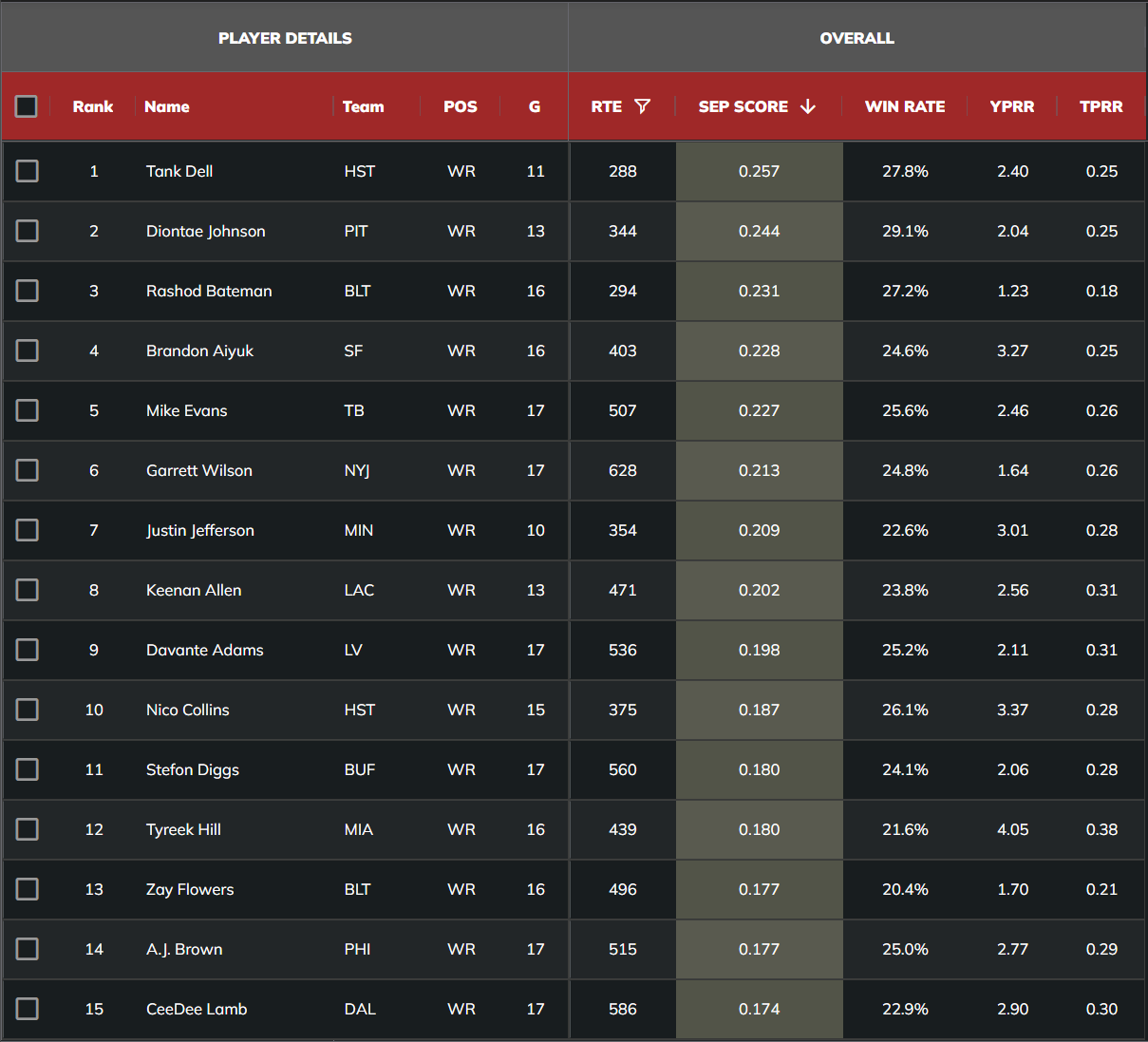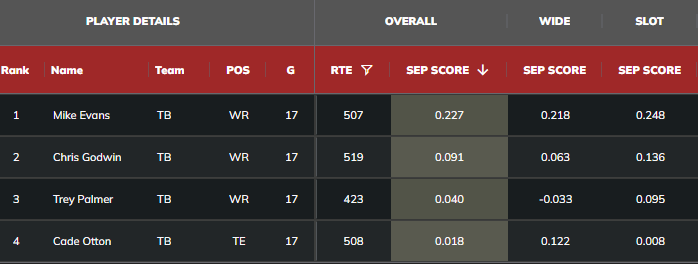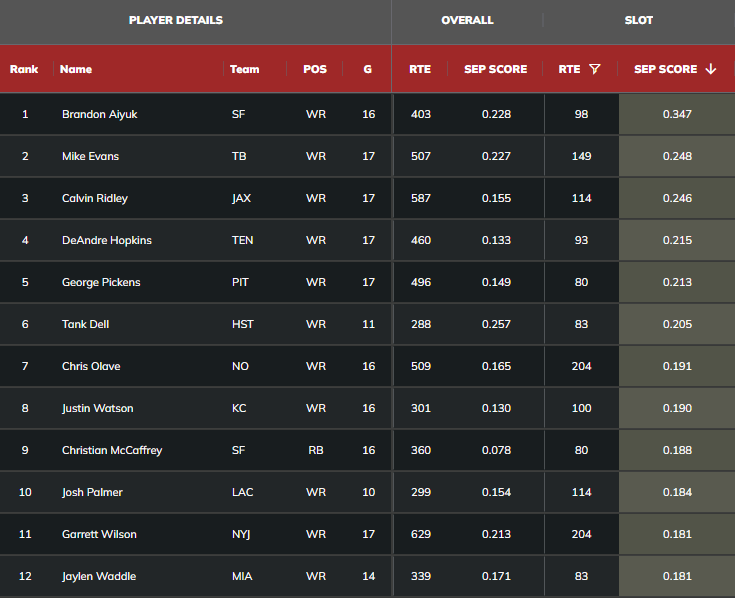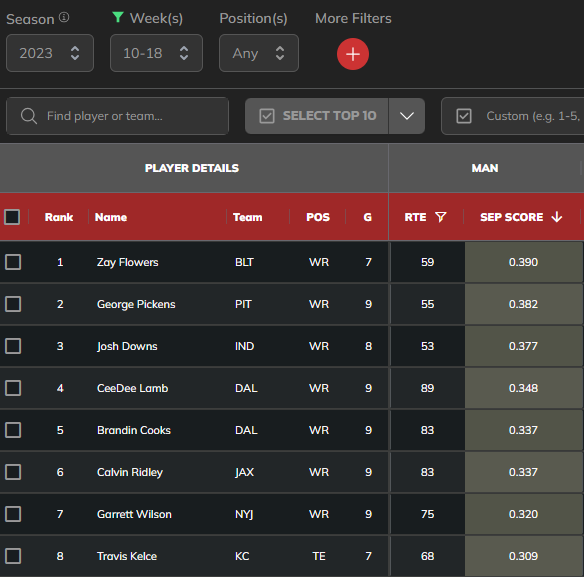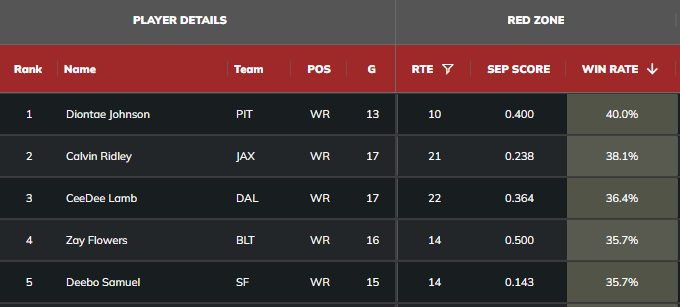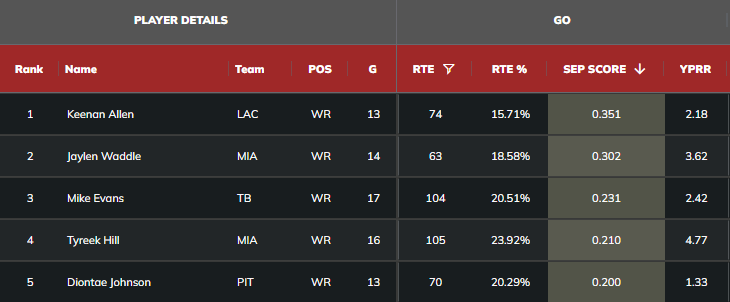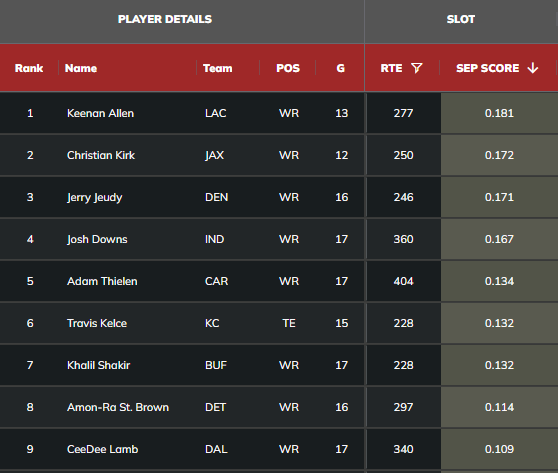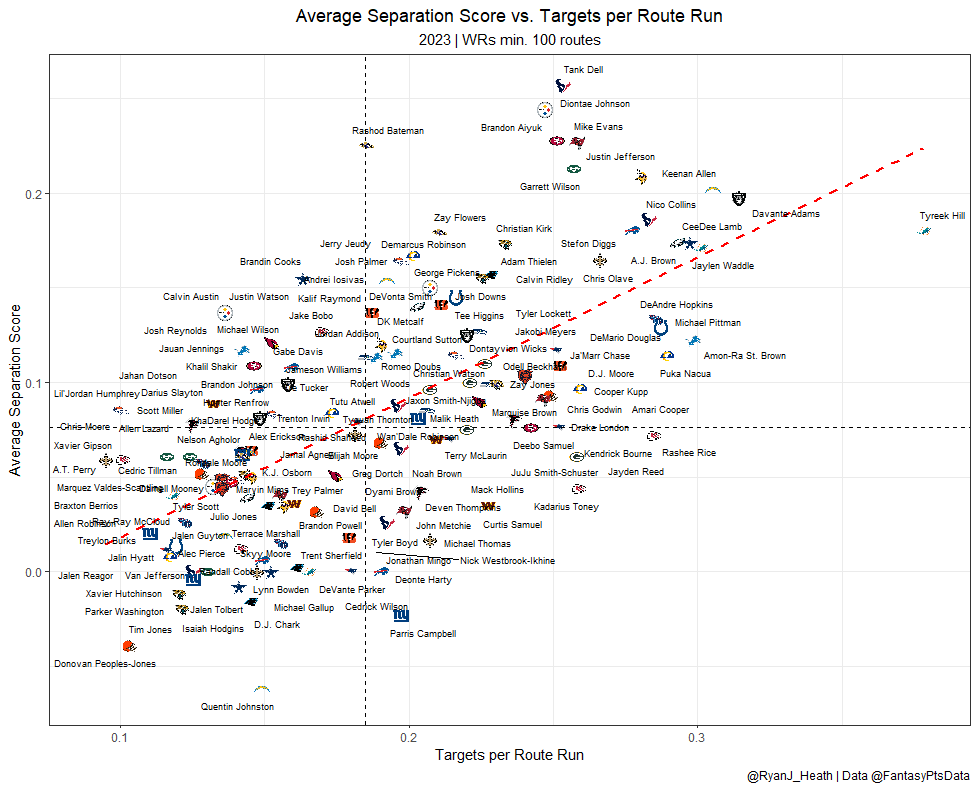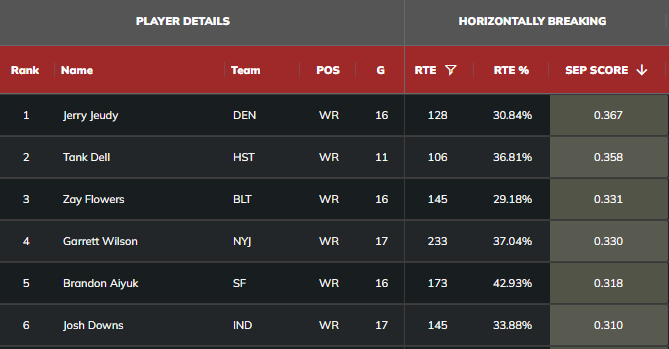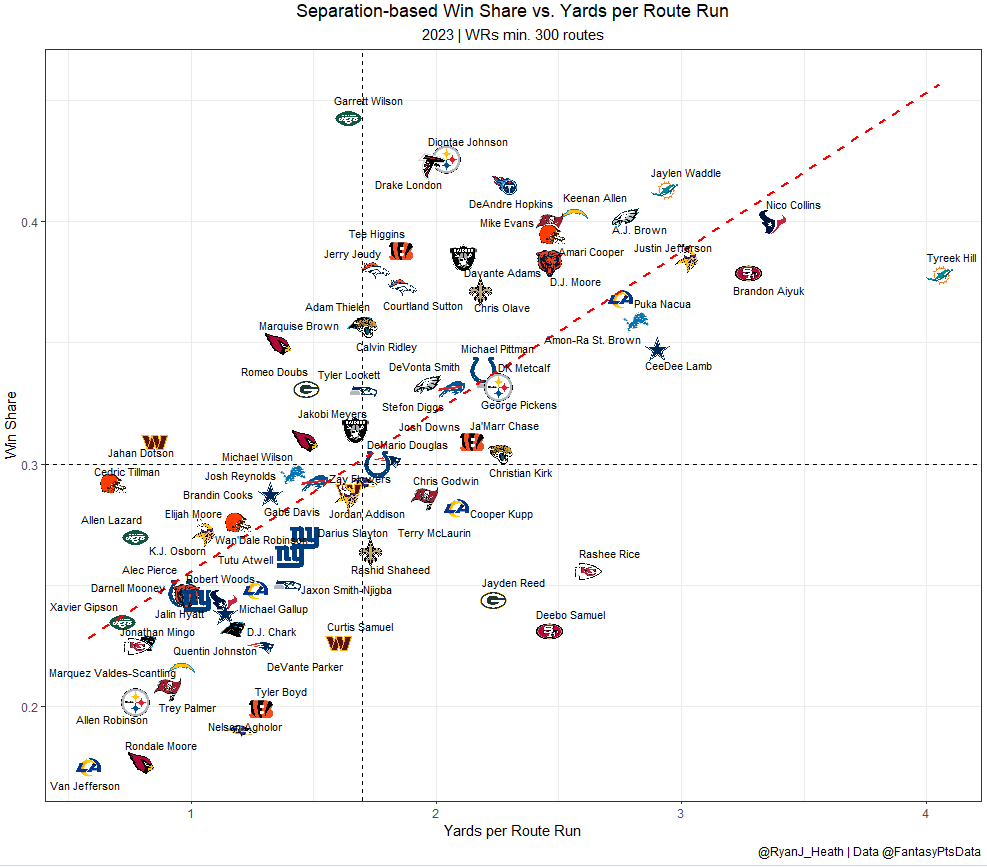If there’s one thing you’ve come to know us for at Fantasy Points, it’s Dank Stats. And with the release of Average Separation Score (ASS), we now have the Dankest Stat ever invented.
To celebrate, Scott Barrett and Ryan Heath teamed up to drop 28 of the dankest of the dank stats on ASS, grouped together into sections for ease of reference. (Also be sure to read to the end for four secret, bonus dank stats).
Further down, we also discuss players who surprisingly (or unsurprisingly) underperformed in average separation score, as well the one key question you didn’t even know you wanted the answer for until today – “Who are the top sleepers and breakouts according to ASS this year?”
THE TOP 15 SEPARATORS
1. Tank Dell had the best ASS in football last year, recording a 0.257 separation score. He did this as a rookie. Although Nico Collins and Stefon Diggs go 1-2 rounds earlier in fantasy drafts, this might be a mistake. Last year in games that Dell and Collins both started and finished, Dell had the higher route share while averaging more targets per game and more FPG (16.3 vs. 15.5).
2. Diontae Johnson is one of the most criminally underrated WRs in football. Although the fantasy production wasn’t quite there, he ranked 2nd among all WRs in average separation score last season (0.244) and 1st in route win rate (29.1%). He’s the only receiver who ranked top-10 in average separation score out-wide, in the slot, against zone coverage, and against man coverage. He also hit career-high marks in nearly every other meaningful efficiency metric. According to ESPN’s Open Score, he’s been a top-5 separator in every other season of his career, and now joins a Carolina Panthers offense otherwise wholly devoid of pass-catchers who can separate. These are just a few of the reasons why he’s been a must-draft pick for us all offseason.
3. Brandon Aiyuk ranked 4th among all WRs in average separation score last season (0.228), well ahead of Deebo Samuel, who ranked 70th of 125 qualifying WRs. That might seem low, but remember, Samuel has always been more of a “YAC god” than an elite separator. He also typically receives the bulk of his targets against zone coverage, which lends itself to more 0 (neutral) separation grades. In my opinion, Aiyuk is the key to San Francisco’s offense, and the 49ers made the right decision to extend him.
4. Mike Evans has still got it! In his age-30 season, Evans finished 7th among all WRs in fantasy points. More importantly or more impressively, he ranked 5th among all WRs in average separation score. For comparison, Chris Godwin ranked just 58th of 125-qualifying WRs in average separation score. But then again, Godwin was far more effective from the slot (0.136) than out-wide (0.063). By YPRR, you see the same thing (2.24 YPRR from the slot vs. 1.78 out-wide). With new OC Liam Coen intent on improving Godwin’s 38.4% slot rate from a season ago, look for a nice bounce-back year from him, and for Evans’ numbers to only take a slight hit.
5. Garrett Wilson ranked 6th-best among all WRs in average separation score last year (0.213), and 5th-best in 2022 (0.248). And, well, yeah… Wilson is awesome. He’s probably already a top-5 WR in the NFL. It’s just hard to tell when you have easily the worst QB in football (Wilson’s -0.170 EPA/play over the last two seasons is exponentially worse than the next-closest qualifying QB). If Aaron Rodgers – who won MVP in each of his last two fully healthy seasons – can just stay healthy, I wouldn’t be shocked if we’re putting Wilson in the Justin Jefferson/Ja’Marr Chase tier a season from now.
6. When I first got my hands on our separation data, I was shocked at how closely the top-12 and bottom-12 lined up with my priors. But we did have one major outlier. ESPN Open Score’s outlier was Kalif Raymond, who ranked 3rd-best of any WR. Ours was Rashod Bateman, who ranked 3rd-best. Maybe this had more to do with Bateman’s role or Baltimore’s scheme (Zay Flowers ranked 13th-best in average separation score and Mark Andrews led all TEs in route win rate), but I’m open to the idea that the former Round 1 pick might actually just be really good (or at least that he’s a terrific fantasy sleeper this year). To support this, HC John Harbaugh thinks Bateman is “going to take a big step and will have a lot more opportunities this year,” and OC Todd Monken has said, “we’re expecting great things from him” this year.
7. “Why does Tyreek Hill rank only 12th in average separation score (0.180)? Isn’t he the best WR in football?” It’s tough to say. We can only grade a receiver based on what the offense asks the player to do. Perhaps he sees tougher coverage than most WR1s, or perhaps he’s “schemed open” more often than most other WR1s (he saw 29 designed targets last year, which ranked 2nd-most among all receivers). Miami has also faced zone coverage at the 2nd-highest rate over the last two years, and this will naturally lead to more zero grades in his score.
8. Though a lot of his targets came on designed plays (27.4%, 2nd-most), Zay Flowers ranked 13th in average separation score as a rookie and may be a better “natural” separator and target-earner than we’ve given him credit for. When removing all designed reads from the Ravens’ offense, his yards per route run actually increases from 1.70 (47th) to 2.19 (41st). The only other rookies to beat Flowers’ average separation score over the past two years were Tank Dell (2023) and Garrett Wilson (2022).
9. Although Tank Dell is the clear ASS king, it’s worth pointing out that Nico Collins also cracked (pun unintentional) the top-10. (By the way, Collins ranked top-40 by average separation score in 2022, which could have been a helpful hint in predicting his breakout). Based on preseason usage, Collins appears likely to run significantly more routes than Dell, who has been coming off the field in 2WR sets. If Collins maintains anything resembling his 2023 efficiency (the 2nd-most efficient season by any WR over the past three years) and this route participation sticks, he should easily lead the team in fantasy points while offering considerably more upside beyond that.
10. In addition to Dell and Collins, Stefon Diggs also ranked top-12 in average separation score. Though C.J. Stroud is an expensive ask at ADP, he ranked as the QB3 in fantasy points per dropback when targeting a receiver with a step or more of separation, and now has access to three of the league’s best separators. From a real-life NFL perspective, Eric Eager (VP of Football Analytics for the Carolina Panthers) found that the quality of a team’s 3rd best pass catcher was more important for predicting playoff winners than a team’s best pass catcher. So, yeah, don’t be surprised if Houston has the best offense in football this year; they clearly have the league’s best wide receiver trio.
BEST SEPARATORS AT OTHER POSITIONS
1. To the surprise of nobody, Christian McCaffrey led all RBs in average separation score last year (0.078). Remember, there were analysts who said McCaffrey would have been a Round 1 pick as a slot WR if he wanted to make the transition to WR. And he probably would have been worth that investment. Last year, McCaffrey ranked 9th-best of 134-qualifying receivers (all positions) in ASS when lined up in the slot (0.188), slightly ahead of Garrett Wilson (0.181) and Jaylen Waddle (0.181).
2. Perhaps a little more surprisingly, Devon Achane ranked 2nd among all RBs in average separation score (0.060). His receiving usage was also fairly unique for an RB, running a position-high 48.3% of his routes from the slot or out-wide. (Only one other RB was over 35%.) Not only that, but Achane actually led all players at all positions in average separation score when lined up out-wide (0.286). Given the minuscule sample size (21 routes), you have to take that last stat with a grain of salt. But even if we do, it’s hard not to drool over Achane’s potential in the passing game. Before Achane ever took a snap on an NFL field, Danny Kelly called him “the Tyreek Hill of RBs.” Earlier this offseason, Dolphins beat writer Travis Wingfield said Achane “might be the next Christian McCaffrey,” that he’s “cooking cornerbacks” in practice, and that he could be “the team’s No. 3 receiver this year.” Put these points in tandem with his more obvious rushing upside – he just set the single-season NFL record for yards per carry – and it’s clear Achane possesses massive league-wrecking fantasy potential.
3. Rhamondre Stevenson ranked 4th-best among all RBs in average separation score (0.045). I know everyone is penciling in Antonio Gibson as the “passing down back” in New England’s backfield. But the analytics suggest Stevenson is the superior pass-catcher in addition to being (more obviously) the better runner. Gibson ranked only 38th of 58 qualifying RBs in average separation score last year. Stevenson also has six games with 50-plus receiving yards over the last two seasons (tied for 4th-most among RBs, and twice as many as Gibson). And he’s now being paid like a bell cow RB (7th-highest salary at the position). Current ADP (RB20) seems to be underrating his fantasy potential.
4. Don’t sleep on Zach Ertz, who quietly ranked 2nd among all TEs in average separation score last year (0.129). I know this is going to come as a huge surprise to a lot of you – after Ertz (in his age-33 season) averaged a pathetic 4.3 YPT last year – but it wasn’t to any film evaluator I’ve talked to. Ertz has always been unathletic and has never given you anything after the catch, but he’s always been and still is a phenomenal route runner. Perhaps he offers a bit more early-season upside than he gets credit for, even if it’s only a matter of time until rookie TE Ben Sinnott supplants him. In 20 full games with Kliff Kingsbury, Ertz averaged 7.5 targets and 12.0 FPG on an 83% snap share. Those numbers would have ranked 4th-, 8th-, and 6th-best among all TEs last year, although he’s going undrafted in all formats, including FFPC TE Premium leagues.
5. Isaiah Likely ranked 8th-best among TEs, just below the top tier that includes Ertz, Mark Andrews, Travis Kelce, and George Kittle. His 46.6 receiving YPG (would have ranked TE9) and 12.1 FPG (TE8) in games without Andrews last year backs up the idea that talent-wise, Likely at worst belongs in the discussion among the league’s second tier of TEs. The two years remaining on Andrews’ contract make that matter less in the short-term, but Likely deserves his status as a trendy dynasty stash and potentially tournament-winning best-ball pick given his contingent upside.
6. Returning to Travis Kelce, his 0.231 average separation score against man coverage ranked best among TEs and top-20 among all positions (min. 60 routes). From Week 10 onward, Kelce averaged a 0.309 separation score against man coverage, a mark only topped by eight WRs across all of last year (Kelce ran just a 65.8% route share over the first half of the season, and was likely hobbled by a preseason knee injury and a Week 5 ankle sprain). For what it’s worth, that second-half score was in line with his 2022 season (0.298), and as Scott DiBenedetto explains, Kelce can still be an elite fantasy producer even if he has lost a step.
COVERAGE SHELLS
1. What’s the most important coverage shell you’d want your WR to be able to separate against? That would have to be Cover 3, which is the most common usage in the NFL. A.J. Brown led all players in both average separation score (0.314) and route win rate (33.3%) against Cover 3.
2. It’s really hard to earn a high separation score against Cover 2. But according to our data, Rashee Rice tied for the lead at all positions in average separation score against Cover 2 (0.167). By win rate, Diontae Johnson led all players (18.3%).
3. Calvin Ridley ranked 2nd among all players with a 38.1% win rate against red zone coverage concepts — those intended to stop the offense from scoring through the air as they approach the end zone. Likewise, Ridley led the NFL with 24 end-zone targets last year, incredibly valuable opportunities that contributed to his WR10 rank by expected fantasy points per game (XFP/G), and which could be indicative of future red zone usage.
4. Returning to the above point about how Brandon Aiyuk is the key to the 49ers’ offense as their primary man-beater, it’s worth noting that George Kittle’s 0.214 average separation score vs. man coverage ranked top-20 among all positions. In six games that either Aiyuk or Samuel has missed over the past two years, Kittle has averaged 17.5 FPG in half-point PPR scoring. For reference, T.J. Hockenson led the position with 11.8 .5 PPR FPG last year.
5. Performance against man coverage becomes more predictive of overall fantasy scoring as receivers age, meaning a decline in average separation score against these looks could serve as a warning sign to avoid certain aging WRs. Keenan Allen and Mike Evans each ranked top-12 in average separation score against man coverage last year, suggesting they haven’t lost a step. Cooper Kupp took a significant step back against man coverage from 2022 (13th-best) to 2023 (38th), though he still bested teammate Puka Nacua. On the flip side, Davante Adams was much better vs. zone (tied 2nd-best) than man (43rd-best). Based on ASS, Adams appears to be a riskier bet than his cheaper aging counterparts.
ROUTES AND ALIGNMENT
1. Keenan Allen, Jaylen Waddle, Mike Evans, Diontae Johnson, and Tyreek Hill made up the top-5 average separation scores on go routes. Despite getting open, Allen and Johnson ranked just 55th and 52nd (respectively) in YPRR on these routes. With new QBs in 2024 (and QB guru Dave Canales joining the Panthers), perhaps both receivers could see more success as downfield threats.
2. Chris Olave was one of only three players to post a better average separation score on crossing routes than Brandon Aiyuk. With former 49ers pass game coordinator Klint Kubiak now the OC for the Saints, Olave could play an Aiyuk-like role that led to unbelievable efficiency. Aiyuk averaged 3.61 YPRR on crossers to Olave’s 2.37 YPRR, and the Shanahan coaching tree has used horizontal routes to great effect. Olave should also benefit from Kubiak’s love of play-action and motion (as Rich Hribar explained here). Over the last two seasons Olave averages 3.13 YPRR with motion, ranking behind only Tyreek Hill and CeeDee Lamb. In spite of his success there, the Saints ranked dead last in the use of motion in each of those two seasons.
3. Last year, 19.3% of Puka Nacua’s route tree was made up of in routes (3rd-most of all players), on which he averaged a 0.28 separation score (12th-best). Cooper Kupp averaged just a -0.09 separation score on these routes (7th-worst among 125 qualifying WRs/TEs). Matthew Stafford targeted a receiver running an in route a league-high 53 times in 2023, the same number as in 2021 and 2022 combined. I’m not sure what this means for the Kupp vs. Nacua debate in 2024, but it is evidence Stafford (and Sean McVay) tailored the offense to the strengths of their best healthy receiver, a skill Stafford might particularly excel at.
4. The hitch was Gabe Davis’s best route by far, on which he averaged a 0.241 separation score (4th-best) and above 2.2 YPRR. Trevor Lawrence targeted hitch routes 100 times last year (3rd-most), and while Evan Engram led all WRs/TEs in targets on these routes (48), Calvin Ridley ran them nearly as often. Davis got significantly better separation on these routes than either Engram (0.00) or Ridley (0.174), which makes me wonder whether his tape on these concepts was part of what motivated the Jaguars to sign him. If Doug Pederson envisions Davis as his Calvin Ridley replacement, he could be in for a sneaky-valuable role.
5. Jaxon Smith-Njigba’s average separation score ranked 48th from out wide (where he ran just 30.8% of his routes) vs. 71st from in the slot (where he ran 69.2% of his routes). His yards per route run splits are even more dramatic, as are his splits on early vs. later downs. If Smith-Njigba becomes a full-time player on the outside under new OC Ryan Grubb, we could witness a dramatic turnaround from his disappointing rookie season.
MISCELLANEOUS
1. What happened with Adam Thielen and Stefon Diggs in the second half last year? Did the age cliff hit Thielen like a sack of bricks? Was Diggs just a victim of usage and play-calling, or was he a less effective separator as well?
Diggs ranked 9th among all WRs in YPG through the first 10 weeks of the season (86.8) up until OC Ken Dorsey was fired. From Week 11 on, under Joe Brady, Diggs ranked just 58th in YPG (45.0). By average separation score, Diggs fell from 9th-best under Dorsey (0.208) to 25th-best (0.136). So, even at his worst, it seems Diggs is far from washed, even if his performance did decline as the season dragged on.
Through the first eight weeks of last season, Thielen (at 33 years of age) ranked 7th among all WRs in FPG (20.2). But from that point on, he ranked just 54th in FPG (8.9). By average separation score, Thielen fell from 9th-best (0.214) through the first eight weeks to 44th across the remainder of the season (0.112). So, it does appear his fantasy decline was largely due to a dropoff in performance. This isn’t all that surprising. DFS players have long known that the best and only time to roster post-age cliff players is in the earliest portion of the season. Perhaps that will be the move again this year, with players like Travis Kelce (turning 35 in October), Keenan Allen (age 32), and Raheem Mostert (age 32). If you draft them in your start/sit league, you’ll probably want to sell high on them early in the season. Or, you might just be better off fading them and playing them in DFS only in the earliest part of the season.
2. Last season Josh Downs ranked 4th-best among all WRs (min. 225 slot routes) in average separation score from the slot (0.164), behind only Keenan Allen (0.181), Christian Kirk (0.172), and Jerry Jeudy (0.171). Downs also ranked 2nd-best against man coverage (0.323), on a top-6 list that includes Garrett Wilson, Mike Evans, Tyreek Hill, Brandon Aiyuk, and Keenan Allen. Downs has been a Fantasy Points favorite all offseason, given how he nearly matched Pittman in production when both players were fully healthy and/or were on the field at the same time. But keep in mind, Downs did this last year as an injury-plagued rookie, and Pittman is a Round 3 pick on ESPN while Downs is typically going undrafted.
3. Over the past two seasons, the best separator among Kansas City WRs has been former Round 5 pick and Ivy Leaguer Justin Watson, with no qualifying Chiefs WRs ranking inside the top-30 during either season. Mahomes’ weapon cabinet has been as bare as advertised, and both Rashee Rice (ESPN ADP: WR33) and Xavier Worthy (WR40) are likely way too cheap in drafts due to fantasy managers’ lingering frustrations with the inferior talents that have graced this offense in recent years.
4. Are horizontally breaking routes a cheat code? Receivers average 0.32 fantasy points per route run on horizontally breaking routes, compared to just 0.25 on vertical routes, a +28% difference. Horizontal routes appear to be an important ingredient to the success of Shanahan-style offenses. They’re also a part of what makes Brandon Aiyuk (who averaged a 0.318 average separation score on these routes, 5th-best) so special. So which WRs stand out as the best horizontal route runners on their teams?
Tyler Lockett averaged a 0.196 separation score on horizontally breaking routes, compared to DK Metcalf’s 0.098 and Jaxon Smith-Njigba’s 0.109. Any thoughts of Tyler Lockett being washed and making way for a Smith-Njigba breakout may prove premature.
Josh Downs’ 0.306 average separation score on horizontally breaking routes (6th-best) blew Michael Pittman (0.132) out of the water.
Josh Palmer (0.290, 7th-best) had a slight advantage over Keenan Allen (0.229, 28th) here last year. With D.J. Chark (-0.028, 5th-worst among 121 qualifying WRs), Quentin Johnston (-0.126, 2nd-worst), and oft-injured rookie Ladd McConkey now Palmer’s only target competition, he has a chance for a career year.
Dontayvion Wicks led Packers WRs with a 0.211 average separation score on horizontally breaking routes, which he ran a team-high 46.3% of the time. Romeo Doubs (0.161), Christian Watson (0.141), and Jayden Reed (0.096) ranked significantly lower.
- Calvin Ridley’s (0.284, 9th-best) arrival in Tennessee could see him seize the WR1 job in the face of a banged-up DeAndre Hopkins (0.193) and a fading Tyler Boyd (0.065). Head coach Brian Callahan has said he’ll deploy Ridley in the Ja’Marr Chase role.
BREAKOUTS AND DEEP SLEEPERS
Can average separation score be used to identify sleeper candidates and potential breakouts? Yes! In fact, I think it may already have a great track record in doing so.
In 2022, unheralded 5th-round rookie Khalil Shakir led all WRs in average separation score (min. 100 routes) despite finishing the season with only 20 targets and 161 receiving yards. But last year, from Week 8 onward, he led the Bills in receiving yards (536) despite being out-targeted by Stefon Diggs 83 to 36. Truly, an unbelievably insane feat.
So who stands out this year?
Well, I’m staring at the top-35 ASS leaderboards looking for any names that might come as a surprise. And I’m seeing a few who might have come as a shock a few months ago. But today, they all seem like obvious sleeper candidates, at least in best-ball leagues.
Josh Downs, WR, Indianapolis Colts
See: Dank Stat No. 28 for a longer write-up on Downs, who finished 26th of 125-qualifying WRs in ASS (0.145), above Pittman, who ranked 31st (0.129). The only thing I’d add to that is that there’s been plenty of hype to support the assertion that Downs is a significant breakout candidate, and is a much better pick than Michael Pittman at cost.
Here’s what Colts beat writer for The Athletic James Boyd said in late August: “This summer, Josh Downs looked like arguably the team’s best offensive player in training camp before sustaining a high-ankle sprain. Downs’ status for Week 1 is murky, but if fantasy players are willing to take a chance on drafting him without knowing his immediate availability, it may pay off in the long run. Downs was Anthony Richardson’s favorite target in camp, even more so than top wideout Michael Pittman Jr.”
Demarcus Robinson, WR, Los Angeles Rams
Robinson ranked 18th of 125 qualifying WRs in average separation score last year (0.167). The year before that, he ranked 15th of 117 qualifiers (0.210). But maybe we shouldn’t be too surprised.
Robinson went on a tear at the tail-end of last season. After finally supplanting Tutu Atwell as the Rams’ full-time WR3 in Week 14, Robinson scored double-digit fantasy points (half-point PPR) in each of his last five games. Over this span, he averaged 6.8 targets per game (~WR27) and 15.6 FPG (~WR17) on an 80% route share. He represents a terrific value in best-ball leagues priced as the WR78, playing for a Rams offense that routinely leads the league in usage of 3WR sets.
And offseason reports have been highly encouraging. According to the Rams’ top beat writer Jourdan Rodrigue, Robinson is “aging in reverse” and “looks awesome.”
Andrei Iosivas, WR, Cincinnati Bengals
Iosivas ranked 30th of 144 qualifying WRs in average separation score (0.137). Looking only at slot routes (though on a probably-too-small sample of only 22 routes), he improves to 19th-best of 168 qualifiers (0.182). So, perhaps it’s not too surprising that Iosivas has leapfrogged rookie Jermaine Burton in the pecking order and appears locked in as Cincinnati’s starting slot WR.
According to Cincinnati’s top beat writer, Iosivas has “been the offensive star of training camp.” GM Duke Tobin has said “the sky is the limit for him” and everyone from WR coach Troy Walters to QB Joe Burrow and CB Mike Hilton are predicting a big year from the sophomore WR. If Iosivas earns and keeps this role (which seems a lot more likely than current drafters are anticipating), don’t be surprised if he outproduces Tyler Boyd’s 2023 marks by a significant margin — among all 40 WRs to run at least 165 routes from the slot, Boyd ranked 2nd-worst in slot average separation score (0.011).
Jalen Nailor, WR, Minnesota Vikings
Over the last two seasons, Nailor leads all WRs in average separation score (0.28), just ahead of Tank Dell (0.26), Justin Jefferson (0.24), Garrett Wilson (0.23), and Brandon Aiyuk (0.23). The major caveat is that this is on a way-too-small sample of only 72 routes (1,120 fewer than Wilson). And because we don’t yet have an “average separation score over expectation,” it’s possible Nailor was just running a high number of “easy” routes or that he was schemed to perfection.
Nonetheless, it’s encouraging, and perhaps unsurprising that Nailor has been “a star in training camp” and is locked in as the team’s WR3. At a bare minimum, just based on that, he’s an amazing best ball pick, going undrafted in most Underdog leagues. But I’m open to the idea that he might be really good. He’s missed a lot of time the past two seasons due to injuries but averaged 7.46 YPRR as a rookie (on only 24 routes). And before that, he outproduced Jayden Reed and Keon Coleman when he was at Michigan State, averaging 75.6 YPG over his last two seasons (versus Reed’s 71.7 YPG).
COMPARING ASS AND TPRR (MORE SLEEPERS)
In a continued effort to identify potential sleepers, we wanted to look at the average separation score leaders among WRs with a relatively low TPRR. The players far above the line in the graphic above were targeted relatively less often than their separation suggests they could have been. Aside from Rashod Bateman (0.231 ASS / 0.18 TPRR), here’s who stood out the most.
Brandin Cooks, WR, Dallas Cowboys
(0.155 ASS / 0.19 TPRR)
Cooks flashed at the tail-end of last season, scoring the 14th-most fantasy points of any WR from Week 10-on, despite ranking just 28th in targets over the same span. The year before that, with Houston, Cooks ranked 3rd-best in average separation score (0.253), behind only Justin Jefferson (0.257) and Stefon Diggs (0.257). mindblown.emoji.
Fast-forward to 2024, and sure, Cooks is now 31 years old. But this is still an offense that could lead the league in pass attempts, and the team added no new pass-catching weapons while losing WR3 Michael Gallup and replacing him with Jalen Tolbert (who ranked 3rd-worst of 96-qualifying WRs in average separation score last year). Plus, CeeDee Lamb has missed just about all of training camp, giving Cooks ample time to establish a rapport with QB Dak Prescott. He’s an amazing best-ball pick, priced as just the WR57 on Underdog.
Josh Palmer, WR, Los Angeles Chargers
(0.154 ASS / 0.19 TPRR)
Palmer was nearly tied with Cooks in average separation score overall (0.154), but elite against man coverage, ranking 7th-best among 66 qualifiers. One of my favorite takes of the offseason came from Joe Dolan, who said, “Everyone is trying to find this year’s Puka Nacua. But this year’s Nico Collins might be more obvious. To me, that’s Josh Palmer.” Here’s the argument for why Palmer (ESPN ADP: Round 14) is one of the best picks you can make in drafts:
Justin Herbert missed most of training camp with an injury, giving him little opportunity to build rapport with his new receivers. Palmer is the only receiver on the team who has caught multiple touchdown passes from Herbert.
New OC Greg Roman loves Palmer, and even tried to draft him when he was with Baltimore.
Ladd McConkey is probably just a part-time slot WR (at least to start the season) and has always had trouble staying healthy. Quentin Johnston is terrible, recording the worst average separation score of all 93-qualifying WRs (-0.062). Even if Johnston isn’t a starter, his replacement – D.J. Chark – was just as bad, ranking 2nd-worst (-0.016) of 93 qualifiers, ahead of only Johnston.
And I do think Palmer is actually good! Last year, he averaged 1.98 YPRR without Mike Williams on the field (Drake London averaged 1.98 YPRR last year), and 2.48 YPRR as the Chargers’ X receiver (would have ranked 12th-best last year), which is his likely role in 2024. (Keep in mind, Easton Stick was the QB in a number of these games).
Tee Higgins, WR, Cincinnati Bengals
(0.140 ASS / 0.21 TPRR)
I think you have to throw out Tee Higgins’ entire 2023 season. Joe Burrow was an immobile shell of his former self through the first four weeks of the season, and Higgins then dealt with rib and hamstring injuries over the next 7 weeks (4 missed games, 1 additional game on the injury report listed as questionable). Higgins only played in two games where both he and Burrow were fully healthy, in which he averaged 7.5 targets and 89.5 YPG (~WR6).
When Higgins returned from injury, Burrow was already on I.R. with a season-ending wrist injury. In his absence, Jake Browning returned the league’s lowest aDOT (6.3) and rarely ever looked Higgins’ way (13.8% target share). But despite the lack of usage, Higgins ranked 10th-best in average separation score (0.181) after his return from Week 13 onward. At worst, a return to Higgins’ 2021-22 form (when he averaged 14.7 FPG, ~WR20) seems likely. At best, perhaps he’s more involved now after Ja’Marr Chase missed nearly all of training camp with a new OC.
Jerry Jeudy, WR, Cleveland Browns
(0.164 ASS / 0.20 TPRR)
Last season, Jeudy led all WRs with a 0.367 average separation score on horizontally breaking routes (such as crossers, ins, and out routes). And he led all players in average separation score against Cover 0 (0.471), the purest form of 1v1 man coverage a receiver will see in the NFL. Jeudy has long held a reputation as one of the best pure separators in the NFL, and our numbers seem to bear that out, so why hasn’t it ever translated so neatly into fantasy production?
To make a long answer short, separation is massively important, but it isn’t the only thing that matters. In Jeudy’s case, and according to multiple film experts I’ve spoken to: “Jeudy might be the best WR I’ve ever seen when it comes to the 1v1 drill in practice. But he struggles to read defenses, and it seems he doesn’t have a great awareness or understanding of proper route depth.”
Beyond that, Jeudy has been saddled with poor QB play, uncreative offenses, and injuries all throughout his career. But he’s still just 25 years old, and did flash two seasons ago – in 2022, Jeudy averaged 78.8 YPG (WR11) and 17.0 FPG (WR10) in healthy games (60% snap share or higher). If Jeudy can make a leap in the football IQ department (a possible outcome from working with HC Kevin Stefanski and Amari Cooper, whom Jeudy has idolized since watching him play at Alabama) to pair with his elite separation skills, it wouldn’t come as a total shock to me if we were viewing him as a top-12 WR in the NFL a few seasons from now. So, he really might be the single best trade target in all of dynasty fantasy football, given his WR66 ADP.
Negative Outliers / “Why Doesn’t [Superstar WR] Have An Amazing ASS?”
Amon-Ra St. Brown’s average separation score (33rd of 93 qualifying WRs), in comparison to his ADP or typical fantasy points scored, may seem shockingly low. Aside from Ben Johnson loving to force-feed his slot receivers, what’s going on here?
From one of our charters: “The reason St. Brown’s average separation score is so low is purely based on his utilization. The Lions love to get him into holes within or underneath the zone. His best quality is his ability to make contested, tight-window catches and his ability to move with the ball after the catch. So much of his route running is predicated on getting into holes in zone, and that correlates with receiving a lot of '0' scores, which bring his score lower.”
St. Brown’s 7.9 aDOT (17th lowest among WRs) reflects this description, as does his being tied for 19th among WRs in contested targets. A somewhat similar case could be made about Deebo Samuel’s underwhelming average separation score (58th).
Ja’Marr Chase (40th) is another interesting case. In short, “he does not create an insane amount of separation, but is a rare type of player who has such elite contact balance and aggressive hands that he, of all receivers, needs the least amount of separation to make a catch and to create YAC.” To a lesser extent, one might also argue Drake London (57th) falls into this category, though he has significantly less career production to back it up.
Why did Puka Nacua (38th) and Cooper Kupp (46th) post underwhelming average separation scores? Kupp’s injury aside (he ranked top-20 in 2022), Nacua’s stylistic fit with Matthew Stafford is likely a factor. According to one of our charters, “I think on teams with a QB like Stafford and a condensed offense like LA that isn't afraid to thread the needle, being a more physical, strong-handed receiver who separates less isn't as much of a detriment.” As discussed above, Stafford has always been a miracle worker at elevating WR production and seems excellent at playing to the strengths of his receivers.
To sum up this section, separation is not the only way a WR can succeed. It is a big part of the position and a great place to start with an evaluation, but players can and do reach superstar status via overwhelming excellence in other traits. If a player is hyper-productive without great separation, it’s likely he’s doing something else very right.
PLAYERS WHO SUCKED ASS AT ASS
Quentin Johnston and D.J. Chark ranked worst and 2nd-worst among qualifying WRs. This likely means good things for Josh Palmer (more on him below) and Ladd McConkey (once healthy).
DeVante Parker ranked 3rd-worst. He retired earlier this spring.
Michael Gallup ranked 4th-worst. He retired this summer.
Jonathan Mingo (lost his job to Diontae Johnson and Xavier Legette), Van Jefferson (banished to an Arthur Smith offense), Skyy Moore (lost his job to Xavier Worthy and Marquise Brown), Alec Pierce (lost his job to Adonai Mitchell), Nick Westbrook-Ikhine (lost his job to Calvin Ridley), and Michael Thomas (without a job in late August) round out the bottom 10.
The point I wanted to make with this section is that the Average Separation Score aligns incredibly well with the decisions made by actual NFL evaluators. Hopefully, that’s now apparent.
SEPARATION MARKET SHARE
Another new stat built from ASS is Separation Market Share, which measures the share of each team’s total separation wins a WR was responsible for in their active games. Players ranking highly in this stat should, in theory, be the best-positioned to earn targets at a high rate, which is largely what we see in practice.
Remember, when we say “targets are earned,” it doesn’t necessarily mean that a WR who earns 150 targets is elite at separating. It could just mean that all of the other receivers on the team were so much worse.
Some (secret, bonus) stats based on separation market share:
1. Jaylen Waddle (41.3%, 5th-best), not Tyreek Hill (37.8%, 17th-best), led the Dolphins in separation market share last year, despite being knocked off the field quite frequently by minor injuries. If anything, this is a reminder that Waddle is also an elite talent like Hill, and also that two players combining for roughly 79% of a team’s route wins is insane. As we discussed above, De’Von Achane could have a meaningful role as a WR this year as the team looks to address this talent dropoff.
2. One might similarly have expected Drake London (42.3%, 3rd-best) and Kyle Pitts to dominate separation wins on a similarly thin Falcons depth chart, but Pitts nabbed only 20.4%. That ranked just 12th-best among TEs, though on par with players like Sam LaPorta (20.7%, 11th-best) and George Kittle (20.3%, 13th-best), who similarly shared their offenses with alpha WRs.
3. Garrett Wilson created a whopping 44.3% of separation wins by all Jets receivers last year, the most in the league. That fact remains relevant as the Jets have only added a 29-year-old Mike Williams coming off an ACL tear — and ranked 98th out of 139 qualifying WRs by ASS in 2022 — and Malachi Corley, a Day 2 rookie for whom Brett Whitefield highlighted concerns that Corley had not run anything close to an NFL route tree in college. Aaron Rodgers does not have alternative weapons approaching anywhere near Wilson’s separation ability. He’s fully deserving of his Round 1 ADP.
4. After the loss of Jerry Jeudy (who takes his top-20 average separation score and team-leading 38.0% separation market share with him to Cleveland), the Denver Broncos figure to be the most separation-starved team in the league in 2024. The team made no notable additions outside of Josh Reynolds (0.117, 37th), with no other player (including Courtland Sutton) ranking inside the top-40. Especially after cutting Samaje Perine, RB Jaleel McLaughlin therefore projects for the valuable “Darren Sproles” role in Sean Payton’s offense with minimal target competition to boot.


